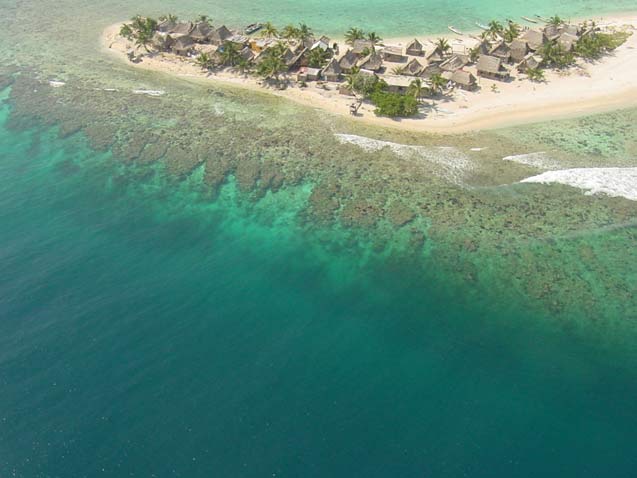
The Cayos Cochinos off Honduras and at the southern end of the Mesoamerican Barrier Reef are a protected area, but that protection – including a strong military presence – rarely extends to the Afro-Indigenous Garifuna communities or their life-ways.
Fausto Blanco gestures out past the vivid aquamarine surrounding the archipelago, towards where the Honduran Navy confiscated the dugout canoe he was navigating to harvest coconuts. Blanco was left stranded in the water and had to swim back to one of the 11 cays that, along with two small islands, make up the Cayos Cochinos. The cays are set towards the southern end of the Mesoamerican Barrier Reef, a coral reef system in the Caribbean Sea second only to Australia’s Great Barrier Reef.
Much has changed in the 20 years since the Cayos Cochinos were declared a protected area. The Afro-indigenous Garifuna communities inhabiting the cays had to fight plans for their eviction, which would have enabled the Smithsonian Tropical Research Institute to create an exclusion zone for scientific study. Today, reality-show production and tourism are facilitated by the Honduras Coral Reef Fund, which manages the area with support from the World Wildlife Fund and The Nature Conservancy. Even with the onslaught of tourism and film crews, Garifuna subsistence fishermen and divers remain subject to ever-changing fishing restrictions enforced by the Honduras Coral Reef Fund and by the Navy.
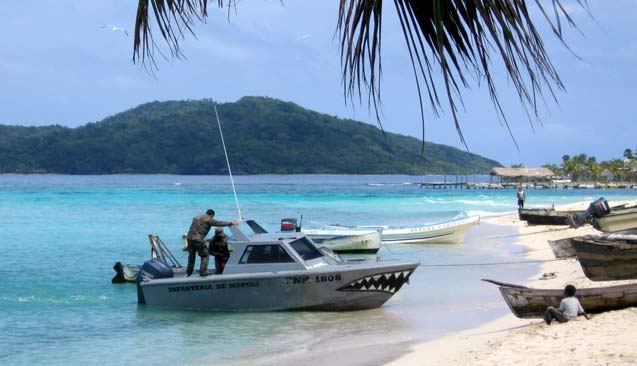 A Garifuna boy sits next to a traditional dugout canoe, watching a naval patrol boat arriving at Chachahuate. (Photo: Sandra Cuffe)
A Garifuna boy sits next to a traditional dugout canoe, watching a naval patrol boat arriving at Chachahuate. (Photo: Sandra Cuffe)
The surge in US military and police aid to Honduras since the June 2009 coup has included $10 million for three new naval bases along the Caribbean coast, and US training of an elite naval team. It has also led to four indigenous civilian deaths during DEA-run operations. Officially, US military and police aid support efforts targeting drug trafficking and organized crime, but entire Garifuna communities have been targeted with the label “narco-communities.” In addition, conservation in some of the coastal and insular areas that the Garifuna have long depended on to survive is heavily militarized.
Jesús Flores Satuyé faces the consequences of militarized conservation every day. In 2001, when he and two other Garifuna were out diving for spiny lobster and shellfish, the Honduran Navy pulled up and began confiscating their equipment. When Flores Satuyé spoke up, he was shot in the forearm. Unable to fish or dive due to the loss of mobility in his left hand, he began eking a living by taking other Garifuna divers out in the cays in his cayuco – the traditional Garifuna dugout canoe. It was confiscated by the Navy in 2010. “I’m really screwed, because here, the cayuco is what gets us around,” says Flores Satuyé, sitting in a hammock in his unfinished home, cradling his left hand. “Sometimes I go hungry,” he said quietly.
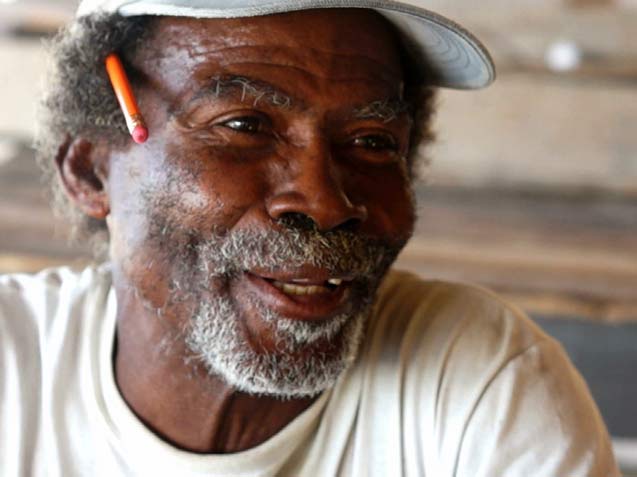 Fausto Blanco had to swim back to the cays after he was stranded in the water by the Honduran Navy. (Photo: OFRANEH)
Fausto Blanco had to swim back to the cays after he was stranded in the water by the Honduran Navy. (Photo: OFRANEH)
For the past few years, Flores Satuyé’s cayuco and those of several other Garifuna fishermen and divers have been sitting exposed to the elements at the small naval base on Cayo Mayor, one of the two larger islands in the coral archipelago. Sometimes, as was the case with Blanco, the Navy confiscated the cayucos at sea, forcing those on board into the water. That practice has led to uneasy doubts about the fate of local fishermen who have disappeared at sea.
Since the Navy began patrolling the cays, long-time fisherman José Buelto Batíz has tracked seven cases of people who have gone out fishing and never returned.
Long-time fisherman José Buelto Batíz is very careful not to make any direct accusations, but since the Navy began patrolling the cays, he has tracked seven cases of people who have gone out fishing and never returned. “It’s the strangest thing. Of those seven disappeared, not a single body was ever found,” he said. “Sometimes we arrive at the conclusion that maybe – and I repeat, I’m not accusing anyone – but if we look at the behavior and arrogance of the Navy, suddenly we could think that they are partly to blame.”
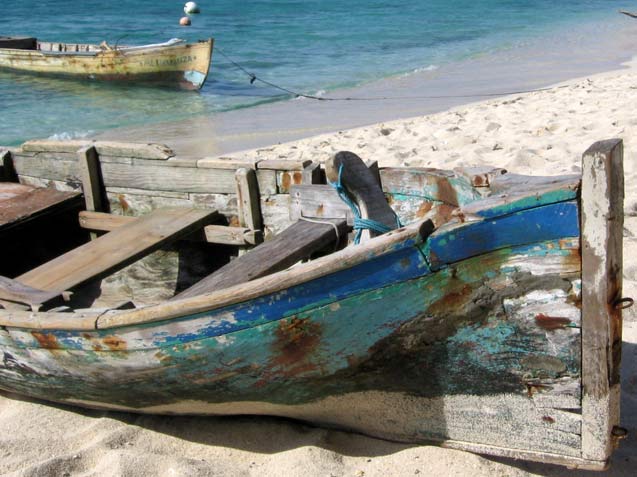 The cayuco – the traditional Garifuna dugout canoe – is the main mode of transportation in the cays. (Photo: Sandra Cuffe)
The cayuco – the traditional Garifuna dugout canoe – is the main mode of transportation in the cays. (Photo: Sandra Cuffe)
In the mid-1990s, Buelto Batíz was at the forefront of the struggle against the eviction of the Garifuna communities inhabiting the cays. Now in his 70s, he is gradually losing his eyesight and hearing, and is no longer able to fish. But his mind is sharp, and he explains the historic ties between the cays and coastal Garifuna communities as he walks along the dirt road in his home community of Nueva Armenia.
Six nautical miles from the cays, Nueva Armenia is the sister community to Chachahuate, the largest cay community. Roughly 250 feet by 50 feet, the Chachahuate cay has a population that oscillates between a few dozen and 200 people, some permanent residents and others splitting their time between the cays and the coast. Río Esteban, another coastal Garifuna community, is linked to East End, a small community located on Cayo Mayor, where the elementary school, naval base and a US-owned hotel complex are located. Fishermen from Sambo Creek have traditionally stayed on Cayo Bolaños while fishing in the cays.
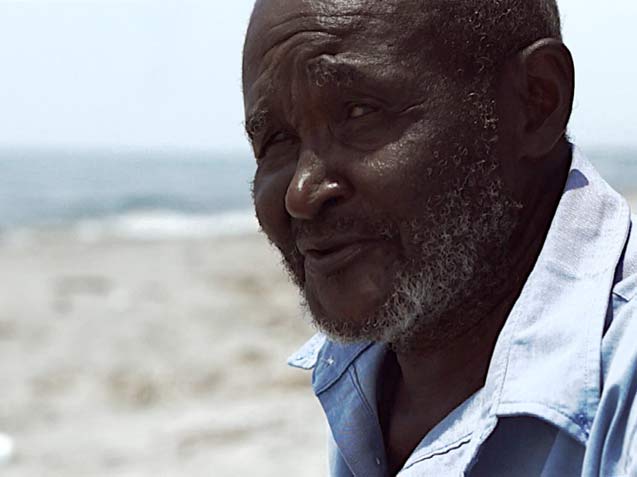 José Buelto Batíz was at the forefront of the struggle against the eviction of Garifuna communities in the Cayos Cochinos. (Photo: OFRANEH)
José Buelto Batíz was at the forefront of the struggle against the eviction of Garifuna communities in the Cayos Cochinos. (Photo: OFRANEH)
The diminishing Garifuna land base on the coast made the fight for the cays even more necessary, according to Buelto Batíz. In the early 1900s, Honduras granted traditional Garifuna lands along the Papaloteca River in concession to the Standard Fruit Company. The community of Armenia was relocated, and the fertile lands that locals used for subsistence farming were occupied by banana plantations. Standard’s concessions expired at the end of the century, but the territorial loss wasn’t reversed. “Instead of returning the lands to the Garifuna, they were given in concession to ranchers,” said Buelto Batíz. Fishing became even more crucial for survival.
In 1993, the Cayos Cochinos were declared a protected area, and were later given National Marine Monument status in 2003. In retrospect, the initial designation had both positive and negative consequences for the Garifuna, according to Reinaldo Colón, president of the patronato, the community governance council, in Chachahuate. “We had industrial fishing boats all around us,” he says, leaning on a windowsill of his wooden home in Chachahuate, facing the crystal waters shining in the midday sun. He glances back every now and then, keeping an eye on his young children eating lunch inside. “Those of us who live here were the last to get the catch because there were boats from [the Bay Islands] that came to fish, to get lobster, and they stayed here.” Protected area status put an end to the large-scale commercial operations and dragnet fishing practices that had been devastating the coral reef ecosystem.
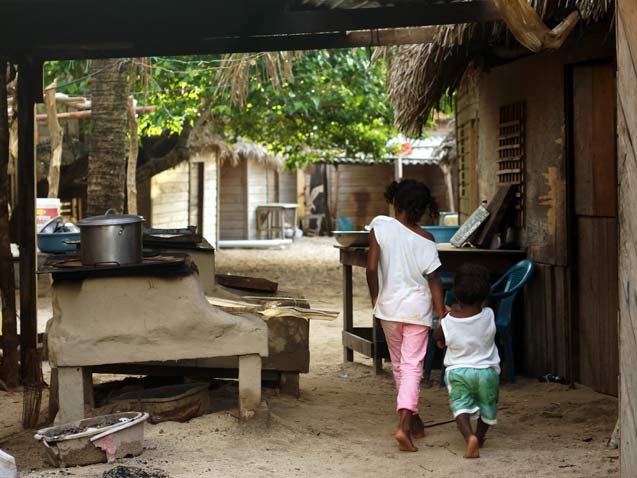 Children from Chachahuate attend primary school on Cayo Mayor, traveling by boat. (Photo: OFRANEH)
Children from Chachahuate attend primary school on Cayo Mayor, traveling by boat. (Photo: OFRANEH)
On the other hand, a total ban on fishing, including local subsistence fishing, was in place for five years following the creation of the protected area and the agreement assigning its management to the Honduras Coral Reef Fund, known locally as “the Foundation.” The 1993 decree mandated the provision by the Armed Forces of assistance, surveillance and police control of the coastal areas, waters and territory of the archipelago. A naval captain and a Honduras Coral Reef Fund representative met with the community of Chachahuate in 1994, offering the inhabitants approximately $1,000 per household to leave, but telling them that they would be forced to leave either way.
“We’re not against the area being reserved and protected. What we’re against is that our rights are being denied, especially the right to feed ourselves.”
“It was terrifying because they wanted the people to leave the cay. But how were we going to leave the cay? It has been part of the heritage of the Garifuna people,” said Juana Celestina Arzú, who coordinated the local divers’ association for years. “We’re not against the area being reserved and protected. What we’re against is that our rights are being denied, especially the right to feed ourselves.”
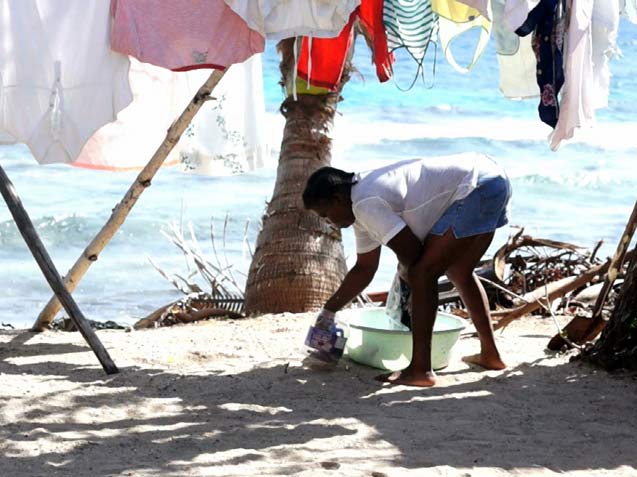 The Garifuna of Chachahuate received a community land title to their cay in 2007. (Photo: OFRANEH)
The Garifuna of Chachahuate received a community land title to their cay in 2007. (Photo: OFRANEH)
The Garifuna successfully resisted the plans for their eviction from the cays in the name of conservation. Communities eventually received communal land titles to Chachahuate, East End and Bolaños in 2007. Residents also succeeded in having the ban on local subsistence fishing and seafood harvesting lifted. In 2004, the first five-year management plan for the protected area came into effect, outlining where, when and how locals could fish. The Honduras Coral Reef Fund involves some local participation in the development of the management plans, but both their process and content are sources of ongoing tensions in the communities.
“They’ve made the management plan with some three or four people. I was participating, but I left, telling them I thought the communities needed to come to a consensus on the management plan,” said Arzú. “From my point of view, I didn’t like that decisions had to be made like this,” she said, snapping her fingers. Arzú withdrew from participating in 2013 after an attendance list from a meeting she attended was used to claim support for the plan from those present, regardless of their positions.
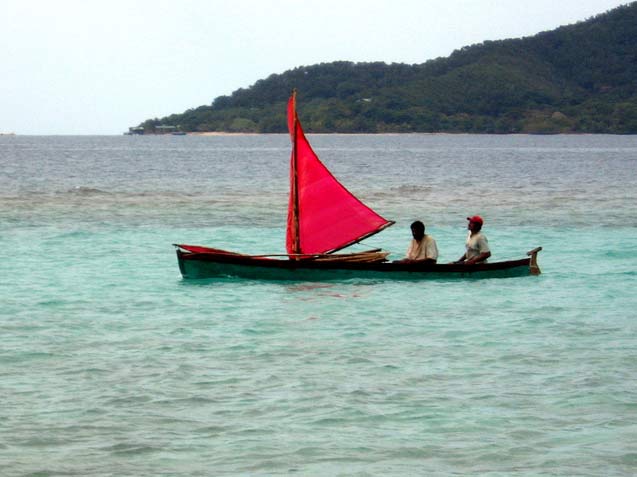 Garifuna fishermen are subject to restrictions enforced by the Navy. (Photo: Sandra Cuffe)
Garifuna fishermen are subject to restrictions enforced by the Navy. (Photo: Sandra Cuffe)
As the president of Chachahuate’s patronato, Colón was invited to participate in meetings leading up to the most recent management plan, now in place for the next five years. Like Arzú, he was concerned that the Honduras Coral Reef Fund was only inviting a small select group of people to participate. He pushed for a community consultation meeting in Chachahuate so that all residents could have a say and develop a management plan that would reflect conservation and community needs. “They told me that yes, they would come, that they would come, and they never came,” said Colón. “That has been our problem with the Foundation. They make decisions without consultation and without alternatives, and that impacts us.”
A boat sits on display outside the Honduras Coral Reef Fund office in La Ceiba, the main city along the country’s Caribbean coastline. A blue dolphin painted on the side of the bright yellow boat contrasts sharply with the shark teeth painted on the bow of the gray naval boats that patrol the cays.
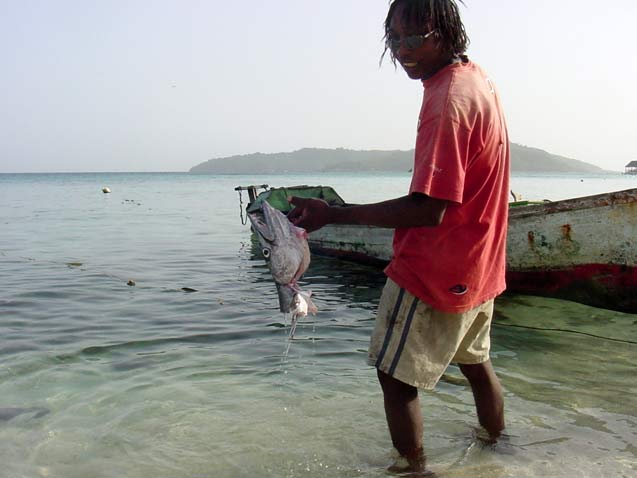 A Chachahuate resident rinses off a barracuda head before preparing a meal. (Photo: OFRANEH)
A Chachahuate resident rinses off a barracuda head before preparing a meal. (Photo: OFRANEH)
Despite a constitutional prohibition on foreign land ownership of islands or any land within 25 miles of the coast at the time, most of the cays had fallen into private hands – including those of Swiss billionaire Stephan Schmidheiny – long before the protected area was created. Initial efforts to establish a reserve were led by a group of elite Honduran businesspeople, who formed a company, Sociedad de Inversiones Ecologicas (SIEC), partnered up with Schmidheiny’s AVINA organization, and bought several cays. They then lobbied the government for protected-area status. In the first few years, the Honduras Coral Reef Fund worked closely with SIEC, AVINA and the Smithsonian Tropical Research Institute. World Wildlife Fund and The Nature Conservancy support followed. Schmidheiny would later be sentenced to 16 years in prison by an Italian court in 2012 for his role as an executive of Eternit, an asbestos company accused of causing thousands of deaths due to workers’ and local residents’ exposure in and around the company’s plants in Italy.
Foreigners continue to maintain ownership of some cay and island properties that are part of traditional Garifuna territory.
Foreigners continue to maintain ownership of some cay and island properties that are part of traditional Garifuna territory. A small but steady stream of day trip, cruise ship, research and other tourists visit the cays, and especially Chachahuate. Cay residents provide occasional overnight visitors with lodging in Chachahuate or East End, sell fish for meals, prepare lunch, rent snorkel masks and sell coconut shell jewelry, but tour operators, foreign hotel owners and the Honduras Coral Reef Fund obtain the bulk of tourism profits. “Others are benefiting from tourism. We always receive the leftovers, the last bit or nothing. We just serve as a stop along the way,” said Colón.
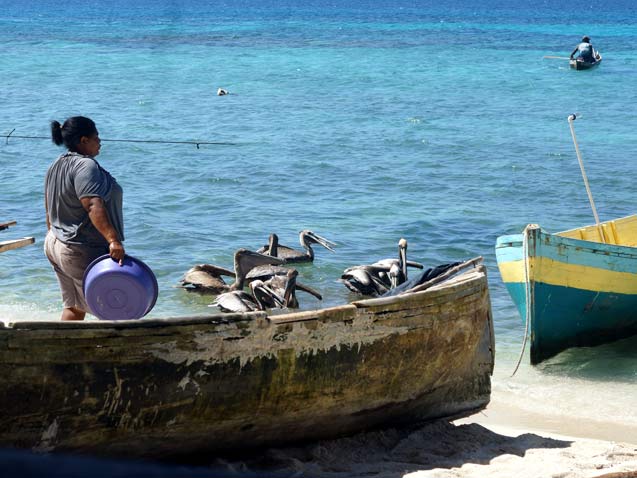 Fishing is crucial to the survival of the Garifuna people. (Photo: OFRANEH)
Fishing is crucial to the survival of the Garifuna people. (Photo: OFRANEH)
Along with small-scale and day-trip tourism, the cays have become a popular filming location for reality television. Since 2006, several Italian, Colombian and Spanish reality show seasons have been filmed on Cayo Timon and Cayo Paloma. Sobrevivientes, a Spanish version of “Survivor,” began filming its 2014 edition in March. While the Honduras Coral Reef Fund has raked in millions of dollars from production companies over the years, fishing activities have been further restricted during filming. Reality-show contestants are often allowed to fish, but Garifuna fishermen have been prohibited from approaching areas where they traditionally catch the small fish they use for bait.
The denial of Garifuna territorial rights and the accompanying pattern of human rights violations in Cayos Cochinos led OFRANEH, a Garifuna federation, to file a petition with the Inter-American Commission on Human Rights in 2003. The petition originally included the cases of two other communities, but was fragmented into several petitions by the commission. The cases of the Garifuna communities of Triunfo de la Cruz and Punta Piedra have now moved on to the Inter-American Court of Human Rights, and two separate cases regarding the cays may not be far behind.
Back in Chachahuate, a naval patrol boat has come and gone, and a cruise ship rests on the horizon. The light turquoise hues of the coralline waters grow darker as the sun begins to set on the archipelago. Three fishermen are coming in for the day, black and red nylon sails guiding their cayucos home. The sea is calm, for now.
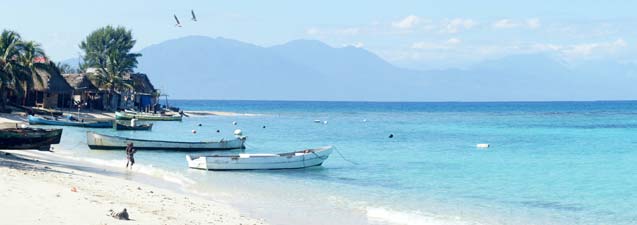 Chachahuate is located in the Caribbean Sea, six nautical miles off the coast of Honduras. (Photo: OFRANEH)
Chachahuate is located in the Caribbean Sea, six nautical miles off the coast of Honduras. (Photo: OFRANEH)
Join us in defending the truth before it’s too late
The future of independent journalism is uncertain, and the consequences of losing it are too grave to ignore. We have hours left to raise the $12,0000 still needed to ensure Truthout remains safe, strong, and free. Every dollar raised goes directly toward the costs of producing news you can trust.
Please give what you can — because by supporting us with a tax-deductible donation, you’re not just preserving a source of news, you’re helping to safeguard what’s left of our democracy.